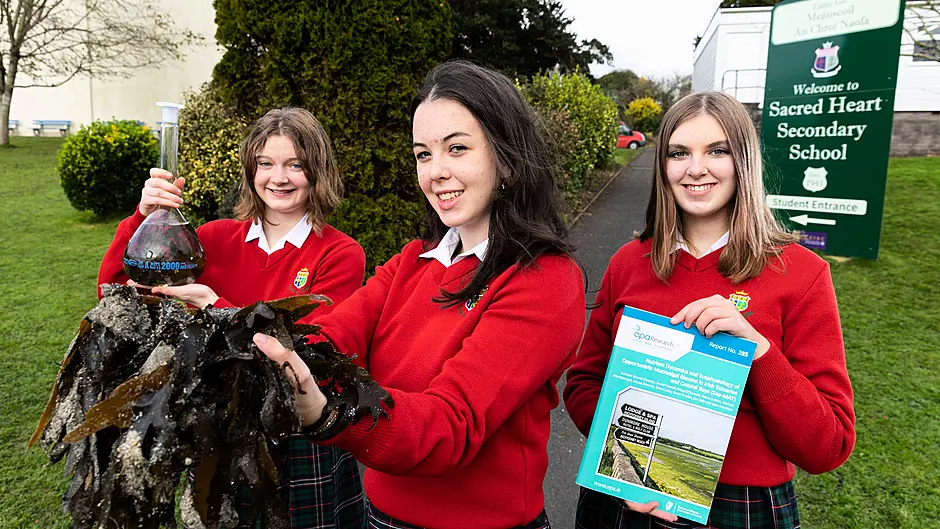Three girls from a West Cork secondary school have used the natural resource right on their doorstep, in Clonakilty bay, to see if it could help in reducing methane emissions from cattle.
Clonakilty students have dived into a major research project to see if their local bay could clean itself, while also reducing emissions from cattle.
Éabha Egan (16) from Ballinascarthy, Sinéad O’Mahony (15) from Clonakilty and Grace Murphy (16) from Ring, all TY students in Sacred Heart Secondary School, took the research on as their BT Young Scientist & Technology Exhibition (BTYSE) project.
They were motivated on a two fronts: to do their bit for climate change, and to help the farming community they live in.
‘If you live around Clonakilty, or in the town, you might know that there is a huge amount of sea lettuce in the bay,’ Éabha explained. ‘Sea lettuce mainly grows due to nutrients – phosphates and nitrates – that leach from the surrounding farmlands and the intensely farmed fields. This results in the bay having high levels of phosphates and nitrates and so sea lettuce grows. Sea lettuce is harmless, but it does smell terrible!’ said Éabha.
‘Cattle produce methane as part of their digestive process,’ Sinéad added.
‘And with growing herd sizes the amount of methane being released into our atmosphere is increasing. There are supplements that can be added to a cow’s diet to reduce their methane emissions. One of these is a red seaweed called asparagopsis armata, which needs phosphates and nitrates to grow.
‘So, we figured why not combine these two things and see if the water from Clonakilty bay could be used to grow asparagopsis armata? In doing so the bay could clean itself (the levels of phosphate and nitrates would go down) and the seaweed could be used to reduce methane emissions from cattle.’
Not surprisingly such an ambitious project required months of work.
It started by getting a sample of the seaweed from NUIG scientists.
‘We then grew the seaweed in optimal conditions so that we could cultivate enough to actually start our experiments,’ Grace explained.
They worked on seven different seaweed samples in various conditions, which they weighed weekly, a task which took at least two hours every time.
There was also weekly seawater sampling at various locations including Ring and Inchydoney, with nutrient testing done by MTU.
Through their painstaking research they demonstrated that aparagopsis armata can reduce the amount of nitrates and phosphates in the sea water.
‘These findings are very important as it can be used as a natural tool to counteract high levels of nitrates and phosphate in highly polluted areas,’ said Éabha.
Ultimately, while they showed asparagopsis armata can be propagated in the water surrounding Clonakilty bay, it is not at the high level that would required because of a low water turnover rate.
‘There are not enough nutrients present in the sea water in Clonakilty bay to encourage the growth of a large crop of asparagopsis armata.
However, if alternative methods for the cultivation of asparagopsis armata were developed, these may generate a supply that could be added to the diet of our national herd thereby, decreasing the production of methane gas in Ireland, they concluded.
All in all it was a major undertaking for the girls, along with their teacher Claire Holland. ‘But it was definitely worth it,’ Éabha said. ‘And we plan to continue with our project for another competition, Sci Fest competition, later on this year.
‘The project has really highlighted and promoted the growth of our love for science,’ agreed Grace.
‘It was amazing to be included alongside so many other fantastic, mind blowing projects in the BT Young Scientist competition.’







